Most of the electronic circuits used in Circuitstoday.com have different applications of the transformer. Therefore, it is important to know the working principle, construction and types of transformers used in different analog circuits.
What is a transformer?
A transformer can be defined as a static device which helps in the transformation of electric power in one circuit to electric power of the same frequency in another circuit. The voltage can be raised or lowered in a circuit, but with a proportional increase or decrease in the current ratings. In this article we will be learning about Transformer basics and working principle
Transformer – Working Principle
The main principle of operation of a transformer is mutual inductance between two circuits which is linked by a common magnetic flux. A basic transformer consists of two coils that are electrically separate and inductive, but are magnetically linked through a path of reluctance. The working principle of the transformer can be understood from the figure below.
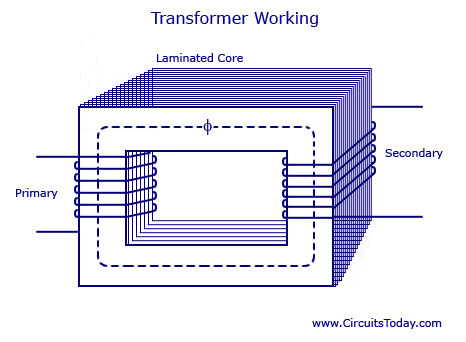
As shown above the electrical transformer has primary and secondary windings. The core laminations are joined in the form of strips in between the strips you can see that there are some narrow gaps right through the cross-section of the core. These staggered joints are said to be ‘imbricated’. Both the coils have high mutual inductance. A mutual electro-motive force is induced in the transformer from the alternating flux that is set up in the laminated core, due to the coil that is connected to a source of alternating voltage. Most of the alternating flux developed by this coil is linked with the other coil and thus produces the mutual induced electro-motive force. The so produced electro-motive force can be explained with the help of Faraday’s laws of Electromagnetic Induction as
e=M*dI/dt
If the second coil circuit is closed, a current flows in it and thus electrical energy is transferred magnetically from the first to the second coil.
The alternating current supply is given to the first coil and hence it can be called as the primary winding. The energy is drawn out from the second coil and thus can be called as the secondary winding.
In short, a transformer carries the operations shown below:
- Transfer of electric power from one circuit to another.
- Transfer of electric power without any change in frequency.
- Transfer with the principle of electromagnetic induction.
- The two electrical circuits are linked by mutual induction.
Transformer Construction
For the simple construction of a transformer, you must need two coils having mutual inductance and a laminated steel core. The two coils are insulated from each other and from the steel core. The device will also need some suitable container for the assembled core and windings, a medium with which the core and its windings from its container can be insulated.
In order to insulate and to bring out the terminals of the winding from the tank, apt bushings that are made from either porcelain or capacitor type must be used.
In all transformers that are used commercially, the core is made out of transformer sheet steel laminations assembled to provide a continuous magnetic path with minimum of air-gap included. The steel should have high permeability and low hysteresis loss. For this to happen, the steel should be made of high silicon content and must also be heat treated. By effectively laminating the core, the eddy-current losses can be reduced. The lamination can be done with the help of a light coat of core plate varnish or lay an oxide layer on the surface. For a frequency of 50 Hertz, the thickness of the lamination varies from 0.35mm to 0.5mm for a frequency of 25 Hertz.
Types of Transformers
Types by Design
The types of transformers differ in the manner in which the primary and secondary coils are provided around the laminated steel core. According to the design, transformers can be classified into two:
1. Core- Type Transformer
In core-type transformer, the windings are given to a considerable part of the core. The coils used for this transformer are form-wound and are of cylindrical type. Such a type of transformer can be applicable for small sized and large sized transformers. In the small sized type, the core will be rectangular in shape and the coils used are cylindrical. The figure below shows the large sized type. You can see that the round or cylindrical coils are wound in such a way as to fit over a cruciform core section. In the case of circular cylindrical coils, they have a fair advantage of having good mechanical strength. The cylindrical coils will have different layers and each layer will be insulated from the other with the help of materials like paper, cloth, micarta board and so on. The general arrangement of the core-type transformer with respect to the core is shown below. Both low-voltage (LV) and high voltage (HV) windings are shown.
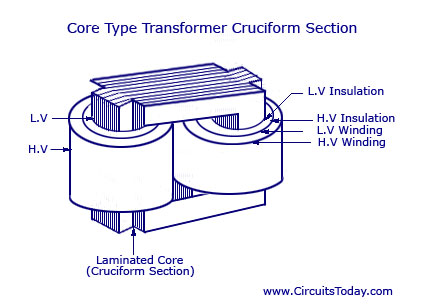

The low voltage windings are placed nearer to the core as it is the easiest to insulate. The effective core area of the transformer can be reduced with the use of laminations and insulation.
2. Shell-Type Transformer
In shell-type transformers, the core surrounds a considerable portion of the windings. The comparison is shown in the figure below.
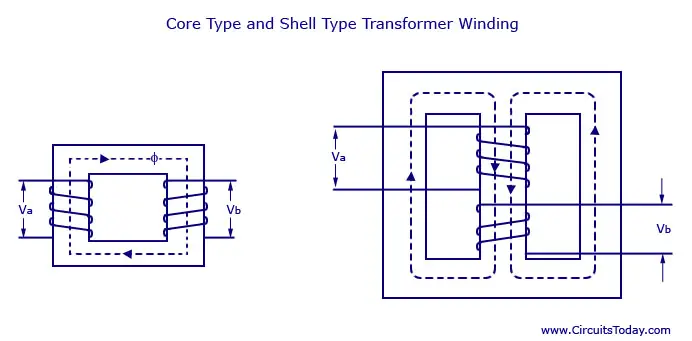
The coils are form-wound but are multi layer disc type usually wound in the form of pancakes. Paper is used to insulate the different layers of the multi-layer discs. The whole winding consists of discs stacked with insulation spaces between the coils. These insulation spaces form the horizontal cooling and insulating ducts. Such a transformer may have the shape of a simple rectangle or may also have a distributed form. Both designs are shown in the figure below:
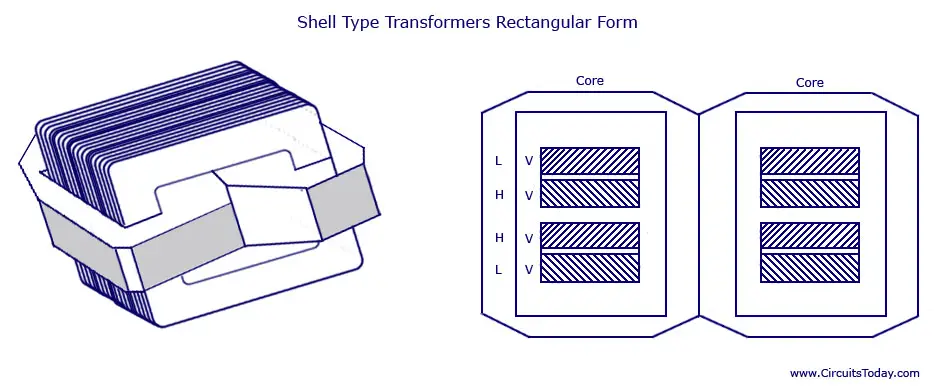
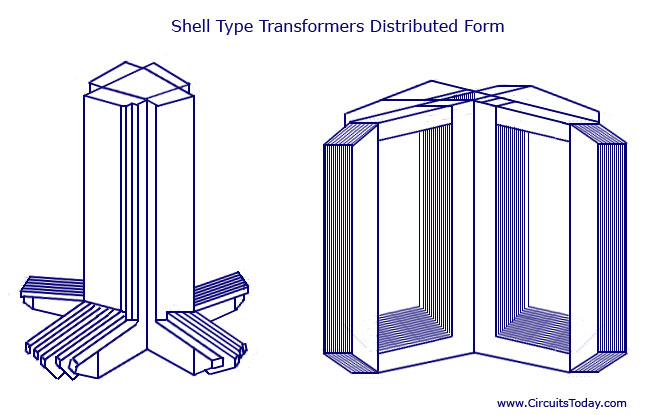
A strong rigid mechanical bracing must be given to the cores and coils of the transformers. This will help in minimizing the movement of the device and also prevents the device from getting any insulation damage. A transformer with good bracing will not produce any humming noise during its working and will also reduce vibration.
A special housing platform must be provided for transformers. Usually, the device is placed in tightly-fitted sheet-metal tanks filled with special insulating oil. This oil is needed to circulate through the device and cool the coils. It is also responsible for providing the additional insulation for the device when it is left in the air.
There may be cases when the smooth tank surface will not be able to provide the needed cooling area. In such cases, the sides of the tank are corrugated or assembled with radiators on the sides of the device. The oil used for cooling purpose must be absolutely free from alkalis, sulphur and most importantly moisture. Even a small amount of moistures in the oil will cause a significant change in the insulating property of the device, as it lessens the dielectric strength of the oil to a great extent.
Mathematically speaking, the presence of about 8 parts of water in 1 million reduces the insulating quality of the oil to a value that is not considered standard for use. Thus, the tanks are protected by sealing them air-tight in smaller units. When large transformers are used, the airtight method is practically difficult to implement. In such cases, chambers are provided for the oil to expand and contract as its temperature increases and decreases.
These breathers form a barrier and resist the atmospheric moisture from contact with oil. Special care must also be taken to avoid sledging. Sledging occurs when oil decomposes due to overexposure to oxygen during heating. It results in the formation of large deposits of dark and heavy matter that clogs the cooling ducts in the transformer.
The quality, durability and handling of these insulating materials decide the life of the transformer. All the transformer leads are brought out of their cases through suitable bushings. There are many designs of these, their size and construction depending on the voltage of the leads. Porcelain bushings may be used to insulate the leads, for transformers that are used in moderate voltages. Oil-filled or capacitive-type bushings are used for high voltage transformers.
The selection between the core and shell type is made by comparing the cost because similar characteristics can be obtained from both types. Most manufacturers prefer to use shell-type transformers for high-voltage applications or for multi-winding design. When compared to a core type, the shell type has a longer mean length of coil turn. Other parameters that are compared for the selection of transformer type are voltage rating, kilo-volt ampere rating, weight, insulation stress, heat distribution and so on.
Transformers can also be classified according to the type of cooling employed. The different types according to these classifications are:
Types of Transformers based on Cooling method
1. Oil Filled Self-Cooled Type
Oil filled self-cooled type uses small and medium-sized distribution transformers. The assembled windings and core of such transformers are mounted in a welded, oil-tight steel tanks provided with a steel cover. The tank is filled with purified, high quality insulating oil as soon as the core is put back at its proper place. The oil helps in transferring the heat from the core and the windings to the case from where it is radiated out to the surroundings.
For smaller sized transformers the tanks are usually smooth surfaced, but for large size transformers a greater heat radiation area is needed, and that too without disturbing the cubical capacity of the tank. This is achieved by frequently corrugating the cases. Still larger sizes are provided with radiation or pipes.
2. Oil Filled Water Cooled Type
This type is used for much more economic construction of large transformers, as the above-told self-cooled method is very expensive. The same method is used here as well- the windings and the core are immersed in the oil. The only difference is that a cooling coil is mounted near the surface of the oil, through which cold water keeps circulating. This water carries the heat from the device. This design is usually implemented on transformers that are used in high voltage transmission lines. The biggest advantage of such a design is that such transformers do not require housing other than their own. This reduces the costs by a huge amount. Another advantage is that the maintenance and inspection of this type is only needed once or twice in a year.
3. Air Blast Type
This type is used for transformers that use voltages below 25,000 volts. The transformer is housed in a thin sheet metal box open at both ends through which air is blown from the bottom to the top.
E.M.F Equation of a Transformer
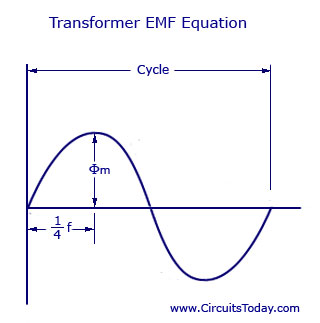
Let,
NA = Number of turns in primary
NB = Number of turns in secondary
Ømax = Maximum flux in the core in webers = Bmax X A
f = Frequency of alternating current input in hertz (HZ)
As shown in figure above, the core flux increases from its zero value to maximum value Ømax in one quarter of the cycle , that is in ¼ frequency second.
Therefore, average rate of change of flux = Ømax/ ¼ f = 4f ØmaxWb/s
Now, rate of change of flux per turn means induced electro motive force in volts.
Therefore, average electro-motive force induced/turn = 4f Ømaxvolt
If flux Ø varies sinusoidally, then r.m.s value of induced e.m.f is obtained by multiplying the average value with form factor.
Form Factor = r.m.s. value/average value = 1.11
Therefore, r.m.s value of e.m.f/turn = 1.11 X 4f Ømax = 4.44f Ømax
Now, r.m.s value of induced e.m.f in the whole of primary winding
= (induced e.m.f./turn) X Number of primary turns
Therefore,
EA = 4.44f NAØmax = 4.44fNABmA
Similarly, r.m.s value of induced e.m.f in secondary is
EB = 4.44f NB Ømax = 4.44fNBBmA
In an ideal transformer on no load,
VA = EA and VB = EB , where VB is the terminal voltage
Voltage Transformation Ratio (K)
From the above equations we get
EB/ EA = VB/ VA = NB/NA = K
This constant K is known as voltage transformation ratio.
(1) If NB>NA , that is K>1 , then transformer is called step-up transformer.
(2) If NB<1, that is K<1 , then transformer is known as step-down transformer.
Again for an ideal transformer,
Input VA = output VA
VAIA = VBIB
Or, IB/IA = VA/VB = 1/K
Hence, currents are in the inverse ratio of the (voltage) transformation ratio.
Applications of a transformer
Transformers are used in most electronic circuits. A transformer has only 3 applications;
- To step up voltage and current.
- To Step down voltage and current
- To prevent DC – transformers can pass only Alternating Currents so they totally prevent DC from passing to the next circuit.
But the application of these 3 applications are endless which is why they have a place in lots of circuits.

74 Comments
Relay good information and details study the Transformer
Thanks for sharing a so excellent file!
Dear sir
so use full for me in study off transformer thanks a lot. and plz shire me all trans.pdf to mail
hello sir my college madam gave me project on transformers and i have very less time to write it so can i submit this page as my project.
this has helped me in my learning about transformers and more so enhance my experience in handling transformers
It’s good. thanku for giving clear information about the device.
Very simple explanation
excellent sir …..
easy to study for student
thanks…… sir
500 kVA transformer fuse range
what is actual meaning of mutual induction
I like this. Not bad at all 🙂
excelent theroy thank you sir……………….
what. is. auto tranesformar
Auto Transformer has single winding, one winding acts primary and secondary winding. it does not provide any electrical isolation.
super
hello this is prasad
I want to names of installation oils in the transformers and ranges of each insulation oil.
please respond to this message
i need transformer calculation involving how to determine the wire gauge and the winding area.
Dear Sir,
Is it possible to design a transformer with rating: Pri:250-0-250 (push-pull type),Secondary: 90000 v @ 5mA,with frequency variable from 5 to 50 Hz, & variable Input voltage : 0-250 v. Please suggest how to design
Awaiting for reply
Gangadhar
I have small doubt about transformer
how we can find that transformer is STEPUP or stepdown.? please answer my question
If you check its resistance then you know whether it is step up or step down.Resistance of primary winding will be high than secondary wing if it is step down, ans same if primary resistance is lower than secondary resistance then it is step up transformer.
If transformer is Setup then the voltage is high and if it is low then it is stepdown
if primary winding is greater than secondary then it is step down transformer, and wise versa.we can find by no. of turns in primary and secondary windings. for example: power output of primary is 1000 and power output of secondary is 500. we know Np/Ns
1000/500= 3.1 ratio
in that we can conclude that, 3 is the primary winding turns and 1 is the secondary winding turns…
respected seetharaman sir….
I am waiting for your reply
please reply as soon as possible
thank you.
what is VA rating???
what indicate it???
for what it should be consider???
‘secondary 30-0-35volt and 3 amp. transformer’ what it’s mean ????
is it transformer fed 3 amp. to load???
what will happen if i connect the load which requires 5 amp. current with transformer has 35-0-35 volt and 3amp. at secondary???
similarly,
what will happen if i connect the load which has requires only 1 amp. with transformer has 35-0-35 volt and 3amp. current at secondary??? load will blow….???
thank you…
30-0-35 volts secondary rating means secondary has tapings which when connected gives different voltages across secondary/load.
When source is 3 amp connecting to higher amp load nothing will happen to secondary as well as load. However if load current is less required and secondary current rated 3 Amp load will get damaged.
why we are considering frequency in AC and why we r not considering frequency in dc
because AC is alternating current and DC is direct current……. in AC frequency is not constant and in DC frequency is constant
Ac supply is alternating in nature means changes positively and negatively in value during every cycle.
No of such cycles per second is called frequency.
In DC there is no variation in value during cycle. That means frequency of DC supply is Zero
Therefore in AC supply frequency is considered.
AC supply generated is proportional to freqencey
EA = 4.44 (f )NAØmax in this formula if we set frequeny (f) on zero (dc mode) then EA =0.
so because of this reason in dc mode no voltage appears on the coils of Transformator.
thanks sir this informtion
very well information sir
i need transformer calculation involving how to determine the wire gauge and the winding area.
Hi
I have a question in relation to transformers.
I have been asked to gig at an outdoor party. I need to power the equipment via a jenny. My problem is the current in the 240jenny often spikes and this would damage or even fry my equipment. I was looking at an uninteruptible power supply for 100euro or else invest in a voltage regulator for 700euro.
My question is is there a transformer which would emit a steady stream of 240v current from the generator or would the spike simply pass through the jenny?
Thanks in advance
Nicky
here are many usefull informations
this is a best fourm.
I like it
thankyou sir your information is good
sir !! useful information !!!! i need to know about multi winding transformer if you help me ?i’ll be thankful to you!!!!!!!
Hello Sir, The explanation is good.. but why we give copper winding rather than the aluminum winding to the magnetic core.. The copper is very cost compare to aluminum.. can we replace the winding.. What about the Output?? More or less… Reply Sir,,, Reply Sir
Enameled aluminum wire can be used for the low voltage and medium current winding. Thin wires are not possible as they tend to break. The loss is high comparing to copper loss. hence loss of energy due to temperature is also will be high.
Thanks sir ur information gud exaplation thanks,thanks
i feel better your information thank u sir
this information is so use full for me so thanks
Good explanation.I would have loved it if there would have been some small clips, step wise, for clear concept.
My frd measure both
windings of ur transformer if one side gives u wide range of value then dats primary winding their other secondary or check ur transformer both sides primary winding wires always red in colour.
Nice , also we need clear explaination of losses
Nice explanatory it is really comprehensive…
But please i’m currently a student in Nigeria…
Kindly help me with the materials needed for the construction of a Transformer and how to obtain the ratings…that this transformer is 20KV, 500KV, 1000KV e.t.c
i would be so glad for your explanatory on this…please…
sir i have pasted the question to design the transformer.
Question:
According to the basic principal of a transformer, construction of two turns in HV winding and one turn in LV winding could work as a ratio 2 transformer. However we could not find such equipment. Why?
if sir can help me to answer with evidences i will be very grateful to sir
i like to estimate eddy losses as well as stray losses, do you have a formula to estimate these losses?…assume it is a two winding one primary coil & one secondary coil..
Dear Sir/Madam,
Please provide me the all metal parts working in transformer’s
Like as:-
# Aluminium Connector
# Bi Metalic Connector
# Lugs
# P.G. Clamps
# Epoxy Bushing
# H.T. & L.T. Fitting
# Copper & Brass Fitting
etc
I hope that you reply me as soon as possible.
with regard’s
Amit Sharma
realy interesting simple to understand
dear sir how to working the transformer
aap se kuchh puchhna chahta hu
electromagnetic induction
in that above explaination is sufficient to know the basics of transformers
sir
Your explanation was super.Its so easy to understand.
thanks sir
ut is more better to me if include classification accorded to core construction
This web site Dos not show how to desing transformers any body need desing for new trans former Mail your volt Ammper in put and out put free send desing derlikonfon@yahoo.com
Your Tutorials are so Easy to understand…..Keep Going……
thanx sir…
Thank you sir
Hello
Excellent was.
Thank you
Hi Lokanandan with the multimeter check the winding resistance. low value is secondary (low voltage) and high (higher voltage)is primary. Using a step down transformer of say 3 to 6 volt feed it to the low resistance winding and check the voltage in the high resistance winding the voltage measured gives you the idea of the ratio of the transformer.
Dear sir,
I have one transformer in that there is not label to know the primary and secondary ,so how to find the primary and secondary of transformer
In transformer primary and secondary are interchangeable.
The winding which is connected to supply side is primary and load side is secondary.
Accordingly in two cases you get as step-up or step-down transformer design.
Means less no of turns on primary and more on secondary gives us step-up voltage transformer and vice-versa
Voltage per turn is same in both the winding
Sir,
How to calculate the current rating of output from a transformer?
I need a Ferrite core transformer, 6V 600mA. I’ve searched it in the market, but they said that it’s not available, rather they have asked to specify the wire thickness and turns so that they can place an order if i want.
If you don’t know the KVA of particular transformer you should have to go through visual check of broth winding primary and secondary and also VOM measured DC resistance of winding with your experience apply small voltage to primary through pot adjust the voltage slowly until get transformer small hum as soon as you hear the hum check the in put voltage and reduce until stop hum measure the input and out put voltage.
Second step now you want to know current rate of such transformer apply the simple OM low I=V/R according to your out put voltage apply pot for out put remember to apply power I2XR when selecting pot, Then fix volts meter to broth side and ammeter to out put and slowly lord the pot by reducing resistance meanwhile check current of out put once out put voltage start to drop check the input also should not drop calculate the percentage fluctuation with your limit or 10 % allowed
So that can your rating VA =Volt x Amp
If you have any puzzled you are free to mail me derlikonfofon@yahoo.com
Hello, Can you give us the calculation of the current thro the conductor and its size
Your problem current through conductor it measured by squire mills for rectangular copper conductor say 1mm x1mm having (1×1= 1) 1mmsqure mil for general measurement 10 amp but this very depend on you application for circular wire (r)2/3.14
Any way if could send me your application I can send you size of wire
If you have any puzzled you are free to mail me derlikonfofon@yahoo.com
Hi HB with 12volt transformer with 230volt tap will give around 220volts due to drop across final transistors. To get 230 volts, 240volt or 250V tapping to be used. For charging with 250volt tapping the secondary will reduce to 11 volt, will not be sufficient for charging. hence more tappings are required to take care of inverter and charging function.
Your problem once the transformer fabricated with two winding you can use either way step up or step down remember to fix change over for vice versa work.
If you want to input 12 volt ac and get out put 220 volt AC that supply to small winding
If you want to 220 volt input and 12volt output supply to big winding
However your problem normal lead acid battery art fully charging required 13.5 volt it seems to be your ac out put voltage is insufficient for battery full 100% charge try to improve out put voltage by tap fixing to primary or re-wind secondary
If you have any puzzled you are free to mail me derlikonfofon@y
rspected sir,
can you pls give some insight on STEP UP transformers which are used in ups..
I see them as different as they have more than two output connections.
I have a book on ups which uses a “inverter cum charging transformer” having 5 outputs named 220v, 230v, 240v, 250v. and mosfet driven inputs of 12v.
My problem is that the specified transformers aren’t easily available in market here, they say you will have to order its make specially which becomes costly.so for some equivalent available replacement
I wanted to know,
1) can a single transformer do both the things(inverter cum charging transformer)
2) can a regular step down transformer be used if reverse connected to produce step up.
thank you.
Dear Sir,
Yeas but use at one time one way
Once the transformer fabricated you can use either way as your application transformer named Step –up or Step down
Bat carful apply the correct voltage to as you desired winding say if you want input 12 volt and get out put 230 Apply 12 volt twelve volt winding
Vice visa the transformer works.
{ dear..?? sir plz give me details about core and winding …..plzzz detail thanks }
I learn lot of things which are valuable for my upcoming exams..i like it